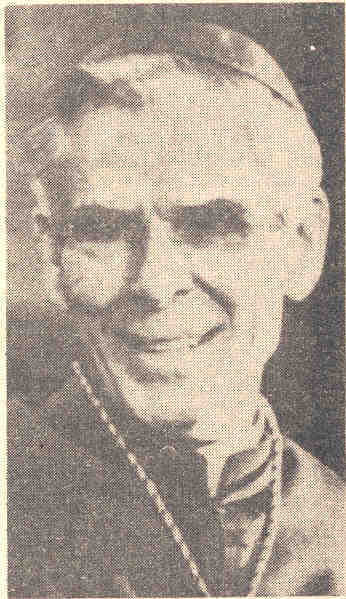(Newspaper
article after Bishop Sheen’s death reprinted here with permission from
the December 10, 1979 issue of the Bloomington (Illinois) Pantagraph.)
Archbishop Fulton Sheen dead
at age 84

NEW
YORK -Archbishop Fulton J. Sheen,
whose radio and television programs made him one of the Roman Catholic
Church's best-known figures in the United States, died Sunday night at
the age of 84.
The
archbishop was an El Paso native.
He
died at his home on Manhattan's upper East Side after a long battle with
heart disease. The body was taken to a New York City funeral chapel.
His
religious commentary program, “The Catholic Hour," began on radio and eventually
spread to television as "Life is Worth Living.”'
“The
Catholic Hour” was begun in March 1930 by the National Council of Catholic
Men, and Sheen was selected as its first preacher. The council estimated
that the radio show reached 7.6 million listeners.
As
national director of the Society for the Propogation of the Faith, Sheen
was known as the instructor of some of the country's most famous converts
to the Catholic faith.
Before
his retirement in 1969, Sheen was credited with bringing into the Catholic
faith, Heywood Broun, a newspaper columnist; automaker Henry Ford II; and
Clare Boothe Luce, the playwright.
He
also brought back into the church Louis F. Budenz, a former editor of The
Daily Worker, the communist newspaper, and Elizabeth T. Bentley, a self-styled
former communist spy.
A
progressive on many social and church matters, Sheen was a relentless foe
of communism. However, he drew a distinction between the ideology and its
adherents.
"The
ideology is wicked, the people are good,”' he once said. "One may hate
communism as an evil system, but still love the communists as creatures
made to the image and likeness of, God and capable of Divine redemption."
In
1967, Sheen urged that then-President Lyndon Johnson unilaterally withdraw
U.S. troops from Vietnam. The next year, he touched off a howl of protest
within the church when he offered a parish church and other buildings for
use in housing the poor, calling it a $68,000 "sacrificial gift."
Sheen
was appointed bishop of Rochester, N.Y., in October 1966, and initially
it appeared that he was giving up his national position for a small diocese
in upstate New York.
But
within a week of his arrival, Sheen became involved in a dispute between
black militants and the management of an Eastman Kodak Co. plant in Rochester
involving the hiring of 600 blacks.
During
the dispute, he declared that, "Stained-glass windows are apt to becloud
our vision of poverty and distress. “
His
concern over poverty marked his numerous books and in his 15 years of service
as director, on Catholic foreign mission fund-raising.
He
moved to New York in 1969 from Rochester.
In
July 1977, Sheen underwent open heart surgery for replacement of a defective
heart valve.
Archbishop
Sheen was born May 8, 1895, in El Paso, above the hardware store run by
his father.He was a son of Newton
Morris and Delia Fulton Sheen. The archbishop was baptized Peter Sheen,
and he took the name John at confirmation. He later adopted his mother's
maiden name.
The
farm-background family moved from El Paso to Peoria when the archbishop
was young. He attended parochial schools in Peoria and graduated from Spalding
Academy in 1913. He completed his theological studies from St. Viator College
in Bourbonnais and St. Paul 's Seminary, St. Paul, Minn.
He
was ordained in Peoria on Sept. 20, 1919.
"I
have no earlier recollections than a desire to be a priest," he once said.
After
he was ordained, he did graduate work at the CatholicUniversity of America
in Washington, D.C.Sheen then went
to the University of Louvain in Belgium, where he later became the first
American to be awarded the Cardinal Mercier prize for international philosophy.
He also attended Angelico University in Rome.
While
in, Europe, he taught at St. Edmund's College at Ware, England, and art
several occasions engaged in public debates with leading European philosophy
teachers.
In
1926, be returned to the United States to do parish work at St. Patrick
Church on Peoria's south side. It was his first and only parish.
"For
all intents and purposes, that was to be my life and I was happy about
it," he said.
But
less than a year later, he left Peoria after being assigned to teach philosophy
at Catholic University.
The
archbishop will not be remembered in El Paso as a man who was a high hat.
When a small group of El Paso natives attempted, in the rnid-1970’s, to
restore the building that is believed to be his birthplace, the then-bishop
humbly discouraged the attention.
George
Drake, El Paso, said Sunday that although the building was torn down, the
group owns the land and still, hopes to honor the El Paso native.
Sheen
returned to St. Patrick in Peoria in 1966 for the parish's 100th anniversary.He
also returned to Peoria for the 75th anniversary of Spalding Academy in
October 1972.
Sheen
returned to Peoria for the last time in 1977 to receive the Order of Lincoln
Award, which is the state's highest honor.
In
1934, Sheen was named a Papal Chamberlain of Pope Pius XI with the title
of very reverend monsignor. Two years later, Pius XI made him a Domestic
Prelate with the title of right reverend monsignor.
For
years, he was an associate professor of philosophy at Catholic University,
where he maintained small office.
On
his desk, he kept a small religious statue and two books - "'Legends of
Saints and Sinners" and "Irish Humour.”